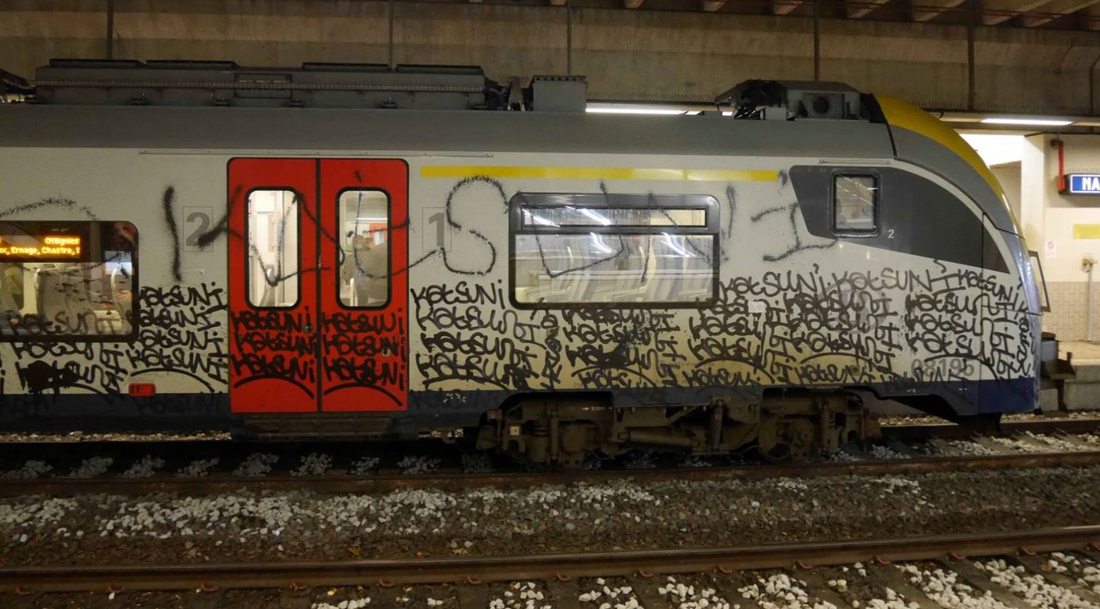
PUNITIONS: THE ART OF VISUAL PUNISHMENT
Share
As September sneaks in, bringing with it the rhythm of a new school year, the sense of freedom from summer quickly fades. The return to school can feel like a heavy punishment—a jarring switch from the carefree days of summer to the structured routines of classes and homework. It’s a kind of punishment we’ve all faced, echoing the discipline we met in our youth. But in the graffiti world, punishment takes on a whole new, artful form.

Imagine a subway car transformed into a blackboard filled with endless, repetitive tags—mark after mark, until every inch of the surface is covered. This is the essence of "Punition," a graffiti style that turns public spaces into a canvas of relentless, rebellious repetition. The term may not be familiar, but you’ve likely seen it: a tag stamped over and over, a visual echo of school-day punishments that demanded writing the same line endlessly.

Graffiti’s Version of Bart Simpson’s Blackboard
If you’ve ever seen Bart Simpson dutifully scrawling lines on a blackboard as punishment, you already know the vibe. In the graffiti world, Punition has a similar ethos: it’s a deliberate, often obsessive, act of tagging that covers surfaces with an artist’s name in a visual rhythm of rebellion. This style was popularized in Paris in the mid-90s by Azyle, a dedicated graffiti writer who paid a high price for his commitment to this unique form of street art.
While Azyle is often credited with bringing Punition into the spotlight, he’s not alone in pushing this aesthetic. Jonone, a New Yorker who’s made Paris his canvas, took Punition to new heights, moving the technique from the underground to murals and even gallery walls. L’Atlas is another artist who adopted this approach, demonstrating how Punition can transcend its gritty origins.


From School Discipline to Subway Art
Punition isn’t just a graffiti phenomenon; it has roots that trace back centuries to classrooms where students were punished with repetitive writing exercises. What started as a teaching tool in the 17th and 18th centuries evolved into a form of graffiti that challenged authority in a different way. In the 90s, Azyle—then known as Ali.06—brought Punition into the graffiti scene by tagging subway cars relentlessly, turning them into moving monuments of his defiance.
Azyle’s story is one of dedication and discipline, though not in the traditional sense. Unlike most graffiti writers who focus on elaborate pieces, Azyle was a purist, driven by the urge to fill train cars with his tag, alone and uncompromising. His commitment was so intense that it bordered on compulsion, a daily grind that resembled a regimented schedule more than the chaotic rebellion we often associate with street art.

A Life of Tagging - Azyle
For Azyle, every day was a carefully planned operation. He faked his way to school in the morning only to spend his day scouting yards, stealing supplies, and tagging the insides and outsides of subway cars. By the time dinner was served at home, he had already marked his presence across the city’s underground, only to slip out at night for more tagging sessions. This relentless pursuit led to his infamous “Grand Slam” on line 7 of the Paris Metro, where every car, inside and out, was covered in his tag within six months.
However, this dedication didn’t come without consequences. In 2016, Azyle faced a high-profile trial that resulted in an eight-month prison sentence and a hefty fine of €136,000 in damages. His case marked a turning point, highlighting the legal risks and personal sacrifices that come with living a life dedicated to Punition.


Punishment’s Waning Popularity
While artists like Azyle, Soack156, Shoe, O’clock, and Buni left their mark with Punition, this form of graffiti seems to be fading. The effort required, combined with the severe legal penalties, may deter new writers from adopting this punishing style. Perhaps the thrill of doing intricate pieces offers a more satisfying payoff, or maybe the risk-to-reward ratio just doesn’t add up.
But one thing is clear: the discipline and commitment required for Punition are unmatched. It’s a testament to the writers’ dedication to their craft and their defiance of authority, even when that defiance comes at a personal cost.
For those interested in diving deeper into the world of Punition, exploring Azyle’s story in Karim Boukercha’s book "Descente Interdite" offers an insightful glimpse into a graffiti artist’s relentless pursuit of his art.

